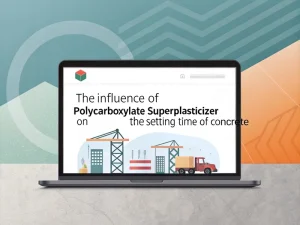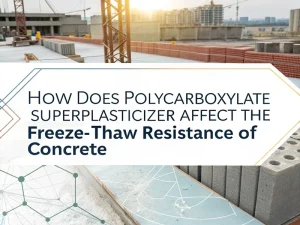
The Influence Of Polycarboxylate Superplasticizer On The Setting Time Of Concrete
Blog The influence of pol
Blog
In the pursuit of more environmentally friendly and durable “green concrete”, slag, as an excellent auxiliary cementitious material (SCM), has become an indispensable role. However, slag has a large surface area and a special mineral composition, which makes it prone to agglomeration and increases the water demand, while decreasing the workability of concrete. At this point, polycarboxylate superplasticizer (PCE), with its customized molecular structure, can seamlessly interact with slag, solving workability problems and maximizing the performance advantages of slag.
This article will explore the mechanism of action between PCE and slag, highlighting the key achievements resulting from their interaction, and provide practical strategies for optimizing their combination.
Before delving into their interactions, let’s first understand the characteristics of these two ‘protagonists’ separately.
Polycarboxylate superplasticizer (PCE): PCE is a high-performance polymer with a unique “comb-like” molecular structure. Its negatively charged main chain adsorbs onto the surface of cement/slag particles, while the dense side chains extend into the water, acting as protective barriers that strongly separate the particles through steric hindrance effects, thereby achieving excellent fluidity with extremely low water usage.
Slag: Slag is a byproduct of the blast furnace ironmaking process. During the ironmaking process, iron oxide is reduced to metallic iron at high temperatures. Impurities such as silicon dioxide and aluminum oxide in iron ore react with lime to form a molten material mainly composed of silicates and aluminosilicates. After quenching, it becomes a loose and porous granular material.
The interaction between PCE and slag is a multi-step process, driven by the comb-like molecular structure of PCE, which features a negatively charged main chain and long, flexible polyethylene oxide (PEO) side chains. This structure enables it to achieve three key mechanisms to optimize the performance of slag in concrete:
The surface of slag particles carries weak positive charges due to the presence of calcium, magnesium, and aluminum ions (in glassy matrix). The PCE main chain is rich in carboxylate groups (- COO ⁻), which are negatively charged and will tightly adsorb onto the slag surface through electrostatic attraction, forming a uniform adsorption layer.
Charge neutralization: The adsorbed PCE main chain will neutralize the positive charge of the slag, weaken the electrostatic attraction between adjacent slag particles, break the initial agglomeration state, and disperse the particles.
Prevent re-aggregation: PCE adsorption will form a “barrier” on the surface of slag, preventing particles from re-aggregating. Unlike traditional water-reducing agents, such as the naphthalene series, the adsorption of PCE under conventional concrete mixing conditions is irreversible and can achieve long-term dispersion effects.
If charge neutralization breaks the initial agglomeration, the long PEO side chains of PCE provide a second guarantee to prevent particle re-aggregation – this is the crucial steric hindrance effect for slag concrete.
Side chain extension: PEO side chains adsorbed on the surface of slag will freely extend into the concrete pore solution, like the bristles of a brush. These side chains exhibit hydrophilicity and maintain a fully extended conformation, thereby forming a physical buffer layer between slag particles.
Barrier particle contact: When adjacent slag particles attempt to approach, the extended PEO side chains collide with each other and generate repulsive forces. This force is sufficient to overcome van der Waals forces and maintain particle dispersion even if cement hydration leads to an increase in solution ion concentration.
Why is slag crucial? Slag hydrates slowly, and particles remain suspended in concrete for a longer period of time – the steric hindrance effect of PCE ensures that they do not re-aggregate during this period, maintaining workability for 60-90 minutes (while slag concrete without PCE can only last for 30 minutes).
At room temperature, slag cannot self-hydrate and relies on the release of calcium hydroxide (Ca (OH)₂) from cement hydration to trigger the volcanic ash reaction. PCE enhances this synergistic effect in two ways:
Enhancing reactivity: PCE evenly disperses slag and cement particles, increases the contact area between slag surface and Ca (OH)₂, accelerates volcanic ash reaction, and promotes early strength development of slag.
Homogenization of hydration products: Without PCE, slag agglomeration leads to uneven distribution of Ca (OH) ₂ – excess Ca (OH)₂ in some areas (weakening the concrete), and insufficient Ca (OH)₂ in some areas (insufficient reaction of slag). The dispersion effect of PCE ensures that Ca (OH)₂ is uniformly consumed to generate more hydrated calcium silicate (CSH) gel (the main “binder” of concrete).
The dispersing effect of PCE on slag reduces the water demand of high slag content concrete by 20% -35%, thereby reducing the water cement ratio (for example, the water cement ratio of 50% slag content concrete can be reduced from 0.55 to 0.35), and reducing the porosity of hardened concrete:
Porosity reduction: The total porosity of slag concrete with PCE added is 8% -12%, while that of slag concrete without PCE is 15% -20%. The pores of the former are mostly closed pores smaller than 100 nm, which prevent water, chloride ions, and chemical substances from penetrating.
Durability improvement: The frost resistance and resistance to sulfate attack of low-porosity reinforced concrete comply with ASTM C666 and ASTM C1012 standards, respectively. For example, after 50 freeze-thaw cycles, the weight loss of PCE slag concrete is less than 5%, while the weight loss of slag concrete without PCE reaches 15%.
The large surface area of slag can easily lead to concrete thickening and difficulty in pumping. PCE solves this problem through dispersion, maintaining good fluidity.
The volcanic ash reaction of slag can last for several years, and PCE ensures that this reaction proceeds fully:
Continuous strength growth: PCE slag concrete exhibits faster early strength development (7-14 days) and long-term continuous hardening. After adding PCE, the 90-day strength of slag concrete with a dosage of 40% reaches 60 MPa, while pure cement concrete is only 50 MPa.
Anti chloride ion penetration: The dense matrix formed by the interaction between PCE and slag reduces the chloride ion penetration rate (according to ASTM C1202 standard) by 40% -50% compared to pure cement concrete, which can protect steel bars from corrosion and extend the service life of bridges, coastal structures, and parking lots.
The biggest advantage of the interaction between PCE and slag is to achieve high slag content, directly reducing concrete carbon emissions:
The emission reduction effect is significant: for every 10% increase in slag content (supported by PCE), the carbon footprint of concrete can be reduced by about 8%. PCE slag concrete with a dosage of 60% reduces carbon emissions by about 48% compared to pure cement concrete.
Supporting sustainable development: The use of slag can also recycle industrial waste from landfills, promoting the development of a circular economy.
Not all PCEs can effectively interact with slag, and it is necessary to choose products that are tailored to the characteristics of slag:
Long PEO side chains: Due to the large surface area of slag, PCE with longer PEO side chains is required to maximize the steric hindrance effect; Short side chains cannot provide sufficient physical separation.
High charge density: The slag surface is positively charged, requiring PCE with a high density of carboxylate groups in the main chain to ensure strong adsorption. Priority should be given to PCEs labeled as “slag adaptation type” or “high SCM performance type”.
Low VOC formula: When used in green building projects (such as LEED certification), opt for PCE with low volatile organic compounds (VOCs) to minimize gas release and meet sustainable standards.
The PCE dosage needs to be adjusted according to the slag dosage – the higher the slag proportion, the more PCE is needed to maintain dispersion:
Avoid overmixing: Excessive PCE may cause concrete to bleed (separate due to moisture) or set slowly (especially in low-temperature environments). Before large-scale production, it is necessary to determine the optimal dosage through a small batch trial of 50-100 L.
To ensure sufficient adsorption of slag and cement particles by PCE, the following mixing process should be followed:
First, dry mix: add cement, slag, and aggregate to the mixer and dry mix for 1-2 minutes to evenly distribute the slag.
Add PCE solution: Dissolve PCE in 70% of the total mixing water, pour into the mixer, and stir for 2-3 minutes.
Add remaining water: Gradually add the remaining 30% water and stir for 1-2 minutes until the target slump is reached.
This sequence can avoid PCE being “wrapped” by dry slag agglomerates, ensuring uniform interaction.
Temperature will simultaneously affect the PCE slag interaction and slag hydration, and targeted adjustments are needed:
Low temperature environment (<10 ℃): The hydration of slag slows down, and the PCE adsorption efficiency decreases. PCE containing a small amount of coagulation-promoting ingredients can be selected, or the PCE dosage can be increased by 0.05% -0.1%.
High temperature environment (>30 ℃): Water evaporates quickly, and PCE may degrade slightly. PCE containing anti-collapsing components should be selected, and the mixing water temperature should be controlled at<20 ℃ to maintain workability.
The interaction between polycarboxylate superplasticizer and slag in concrete is crucial for achieving low-carbon and high-performance concrete. By adsorbing slag particles, providing steric hindrance, and promoting synergistic hydration, PCE not only addresses the workability issues of slag but also enhances its strength, durability, and emission reduction benefits.
By following best practices (selecting PCE for adaptation, optimizing dosage, and controlling slag quality), concrete with higher strength, better durability, and stronger ecological friendliness can be prepared, promoting the construction industry towards net zero emissions.

The Influence Of Polycarboxylate Superplasticizer On The Setting Time Of Concrete
Blog The influence of pol

How Does Polycarboxylate Superplasticizer Affect The Freeze-thaw Resistance Of Concrete?
Blog How does polycarboxy